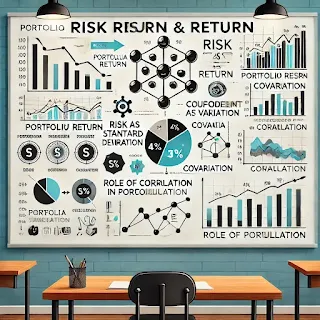1. Introduction to Risk and Return
What is Return?
Return is the reward an investor expects or receives from an
investment. It represents the gain or loss relative to the initial investment.
Types of Return:
- Actual Return: The return realized in the past.
- Expected Return: The return forecasted or anticipated in the future.
Formula:
Return (R) = [(Ending Price - Beginning Price + Dividends) / Beginning Price] ×
100%
What is Risk?
Risk is the possibility that the actual return on an
investment will differ from the expected return. It reflects uncertainty.
Sources of Risk:
- Market risk
- Interest rate risk
- Inflation risk
- Business risk
- Political risk
- Liquidity risk
2. Portfolio Return
When an investor holds multiple assets, the return of the
portfolio is the weighted average of the individual returns.
Formula:
R_p = w1*R1 + w2*R2 + ... + wn*Rn
Example:
Asset A: weight = 0.6, return = 12%
Asset B: weight = 0.4, return = 8%
R_p = (0.6 × 12%) + (0.4 × 8%) = 10.4%
3. Portfolio Risk (Standard Deviation)
Risk is typically measured by the standard deviation (σ) of
returns, which shows the extent to which returns deviate from the mean.
Standard Deviation Formula:
σ = sqrt[Σ(Ri - R̄)^2 / (n - 1)]
4. Coefficient of Variation (CV)
The Coefficient of Variation compares risk (σ) to expected
return (R̄) and helps choose between investments with different returns and
risks.
Formula:
CV = σ / R̄
Interpretation:
Lower CV = more desirable (less risk per unit of return)
5. Covariance and Correlation
What is Covariance?
Covariance measures the degree to which two asset returns
move together.
Formula:
Cov(X,Y) = Σ[(Xi - X̄)(Yi - Ȳ)] / (n - 1)
What is Correlation?
Correlation standardizes covariance to a range of –1 to +1.
Formula:
ρ(X,Y) = Cov(X,Y) / (σ_X * σ_Y)
Example:
Cov(A,B) = 0.002, σ_A = 0.04, σ_B = 0.03
ρ = 0.002 / (0.04 × 0.03) = 1.67
6. Role of Correlation in Portfolio Construction
Correlation determines the risk-reduction benefit of
diversification.
Two-Asset Portfolio Risk Formula:
σ_p = sqrt[w_A²σ_A² + w_B²σ_B² + 2w_Aw_BCov(A,B)]
Or using correlation:
σ_p = sqrt[w_A²σ_A² + w_B²σ_B² + 2w_Aw_Bρ_ABσ_Aσ_B]
7. Summary
|
Concept |
Key Point |
|
Return |
Gain/loss on an investment |
|
Risk (σ) |
Uncertainty of returns |
|
Portfolio Return |
Weighted average of individual returns |
|
Coefficient of Variation |
Risk per unit of return |
|
Covariance |
Measures direction of co-movement |
|
Correlation |
Measures strength of co-movement (–1 to +1) |
|
Diversification |
Works best when correlation is low or negative |
8. Practice Problem
You invest 70% in Asset A and 30% in Asset B.
- R_A = 10%, σ_A = 6%
- R_B = 8%, σ_B = 4%
- ρ_AB = 0.2
Q1: What is the portfolio return?
Q2: What is the portfolio standard deviation?
🔍 Systematic vs. Unsystematic Risk
|
Type |
Description |
Examples |
Can
it be Diversified? |
|
Systematic Risk |
Market-related risk that affects
all securities in the market |
Interest rates, inflation,
recession, political instability |
❌ No (non-diversifiable) |
|
Unsystematic Risk |
Company-specific or
industry-specific risk |
Business risk, financial risk,
labor strikes, product recalls |
✅ Yes (can be diversified away in a well-structured
portfolio) |
📊 Total Risk
Total Risk = Systematic Risk + Unsystematic Risk
Measured by Standard Deviation
(σ) of returns. A high standard deviation means high total risk.
📈 Capital Asset Pricing Model (CAPM)
The CAPM explains the
relationship between systematic risk and expected return on an
asset.
CAPM
Equation:
E(Ri)=Rf+βi(E(Rm)−Rf)
Where:
- E(Ri)E(R_i): Expected return of the investment
- RfR_f: Risk-free rate
- βi\beta_i: Beta of the investment (measures sensitivity
to market movements)
- E(Rm)E(R_m): Expected return of the market
- E(Rm)−RfE(R_m) - R_f: Market risk premium
⚖️
Understanding Beta (β)
- β = 1:
Stock moves with the market.
- β > 1:
Stock is more volatile than the market.
- β < 1:
Stock is less volatile than the market.
- β < 0:
Stock moves inversely to the market.
📌 Implications of CAPM
- Investors are only rewarded for systematic risk.
- Unsystematic risk is irrelevant if investors hold a diversified portfolio.
- CAPM helps determine fair return based on risk.
📉 Risk Reduction Through Diversification
As the number of assets in a
portfolio increases:
- Unsystematic risk
↓ (can be eliminated)
- Systematic risk
= constant (cannot be eliminated)
- Hence, Total Risk ↓ but only up to the level of
market risk.






0 Comments